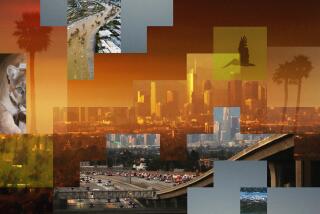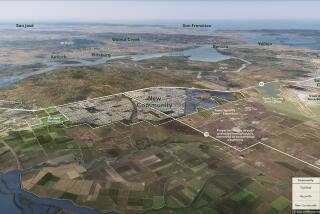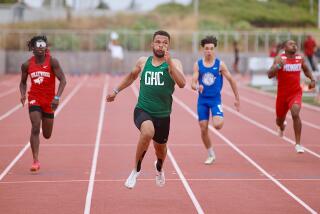Mapping Out a Metropolis for Tomorrow
- Share via
BUENA PARK — The time is somewhere in the second millennium. “And you’re about this tall,” 13-year-old Frank Ramirez told a group of adults as he brought together his thumb and forefinger.
Then, he and two schoolmates from Sequoia Middle School in Fontana took the group--contest judges, actually--through a block of the Sequoia River Forest, a futuristic model of a city the boys created with a computer program and recycled knickknacks. Here, the largest building in the city--a sort of disaster shelter--has a special protective shield around it, designed to withstand any force.
Take a look into the future, ladies and gentlemen, where transportation is powered by magnetic force, water is sweet and the air is pure. It is the future as envisioned by seventh- and eighth-graders from Southern California schools, displayed Saturday in the Future City Competition at Knott’s Berry Farm.
Sixteen schools from four counties participated in the contest, which asks students from around the nation to create models of the city of tomorrow. The winning team, from Ernest Lawrence Middle School in Chatsworth, will compete next month in the finals in the 1997 National Engineers Week Future City Competition in Washington, D.C.
The students first designed their city on a computer, using a program called SimCity, and then they took one block of their city and recreated it into a three-dimensional model. The computer blueprints of the design and the models were displayed Sunday.
“This is a remarkable achievement for any seventh- and eighth-grade student,” said Tim Hanneman, the event committee director.
*
The team from Bernardo Yorba Middle School named their city, appropriately enough, Orange. Cardboard boxes, cups and Styrofoam blocks, in hues of deep orange, red and green, made for a bright model.
“Our traffic [level] is really low and we have very low taxes,” said Ryan Maes, 13.
The team from Lexington Junior High School in Cypress called their city Jonesville. Their model was made mostly of tin cans and sports drink bottles, all spray-painted black or silver.
The silver buildings “absorb the sunlight,” explained Sean Klimmek, 13, and that functions as a heating system. Black was chosen because it goes well with silver.
Jonesville features a magnetic rail system in which trains are fueled by magnetic power. The city’s largest building, crafted from a black sports drink bottle, is called an “arkology.”
“It’s a self-sustaining building where people can live--sort of like something you can launch into space and it wouldn’t need anything,” Sean said.
Even though the team wasn’t one of the finalists in Sunday’s competition, Sean’s teammate, Alex Jochai, said he had fun because he felt challenged.
“I would imagine that it would be hard to try and build the perfect city for the future,” he said.
More to Read
The biggest entertainment stories
Get our big stories about Hollywood, film, television, music, arts, culture and more right in your inbox as soon as they publish.
You may occasionally receive promotional content from the Los Angeles Times.










